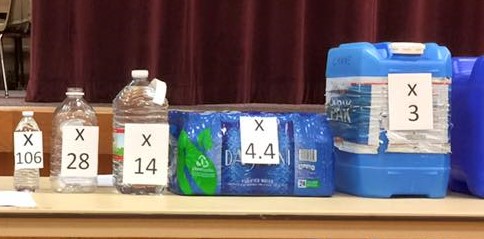Being without water and/or sanitation services can create a serious health situation and be more than just an inconvenience. It is not a situation you should wait to respond to until it occurs. Prepare now.
- Store water.
- Learn how to clarify and to purify water.
- Identify water sources in your home and neighborhood.
- Learn how to conserve water.
- Learn how to minimize wastewater.
- Learn what to do if your sewer system cannot be used.
Although it is difficult and impractical to store water in large quantities, experts recommend that a two-week emergency water supply be stored. Store at least fourteen gallons per person — seven for drinking and seven for other uses. Store even more if there is a baby to care for.
Fourteen gallons is barely enough for drinking and cooking needs. Bathing and sanitary needs will require even more. Store more water (5-10 gallons per person/per day) or learn how to clarify and purify water from other sources and store the supplies and equipment to do so. The more diverse your water sources and methods for obtaining water, the more likely you will not run out.
When choosing a water storage container, remember that water weighs over 8 pounds per gallon. Store water in thoroughly washed, clean, food-grade containers, preferably of heavy PETE or PET plastic (not lightweight plastic that milk comes in) with tight fitting lids. Food grade plastic containers have the advantage of being shatterproof and lighter in weight than glass jugs or bottles. One to five-gallon containers of rigid plastic are best for portable water storage. Glass jugs or bottles with screw tops are acceptable but are heavier and break more easily. Metal containers tend to impart an unpleasant taste to water after long storage. Bleach bottles are not appropriate for storing water for drinking or cooking but are good for storing water for other uses. Water beds may be used for water storage for non-drinking purposes, but an algicide that is food-approved must be used. Additional storage containers include 30- to 55-gallon food-grade barrels and farm supply water tanks. Fill bathtubs with water in emergency weather situations.
Containers should be washed in hot soapy water and sanitized before filling. Sanitize by rinsing the container and lid with a solution of 1 teaspoon of unscented 5-6% sodium hypochlorite bleach in 1 quart (1 liter) of clean water.1
Check containers every few months for leaks. At the same time check the water for cloudiness or undesirable appearance. If an undesirable appearance has developed, the water should be discarded.
Store containers where potential leakage will not cause damage. Store away from heat and light and protect from freezing. Keep containers raised off cement floors.
When stored in clean containers, away from sunlight, and when free from bacteria at the time of storage, chlorinated water will remain safe. Most disease organisms tend to die during long storage. Generally, the longer the water is stored, the safer it will become bacteriologically. To improve taste for drinking, pour water between two containers to add air back into the water.
If the purity of water is in question, purify it with any of the following methods after clarifying:
TO CLARIFY – Pour dirty water through filter paper, cloth, or a mechanical filter. Once the remaining particulate matter has settles, use any of the following methods to purify the clear water on top. (See this page for additional methods for clarifying dirty water.)
PURIFICATION OPTIONS:
FILTRATION – Use ceramic, glass fiber, or compressed paper filters to physically filter particulate matter, bacteria, and protozoa. Use carbon filters to reduce chemicals, poor taste, odors, and pollutants. Water purifiers are necessary to remove or kill viruses which are too small to be removed by a filter.
CHEMICAL – All water purification chemicals should be rotated to ensure their activity. 1) Halazone tablets may be used according to package directions but should not be kept opened longer than 1 year.2 2) Iodine may be used in small amounts. Add three drops of 2% tincture of iodine to each quart of clear water, six drops for cloudy water. Stir thoroughly. The shelf life of liquid iodine is up to 2 years.3 3) Household bleach that contains sodium hypochlorite as its only active ingredient will purify water also. See “Water Purification with Bleach” for detailed instructions for using either 5-6% hypochlorite bleach or 8.25% hypochlorite (concentrated) bleach.
BOILING – Boiling is the easiest and least expensive method to purify water from biological contamination. Boil water for 3-5 minutes at a rolling boil. Higher elevations require longer boiling to compensate for a lower boiling temperature. Add 1 minute for every 1,000 feet above sea level. (See Boil Water Notices for more information.)
SOLAR PASTUERIZATION – Water does not need to be brought to boiling to be pasteurized and safe to drink. Boiling is just a good indicator of temperature and safer when a thermometer is not used. A WAPI in a solar oven will also indicate the correct temperature to pasteurize water. WAPI stands for Water Pasteurization Indicator. The wax in it melts when clarified water has been heated to pasteurization temperatures and is safe to drink. It is a great solution when there is limited fuel available to boil water.
WATER DISTILLATION – Distillation will remove microbes, heavy metals, salts, most chemicals, and radioactive fallout. It is the only method that can purify salt water.
2Christopher and Dolores Lynn Nyerges, extreme simplicity: A Guide to Urban Homesteading
3ibid.

